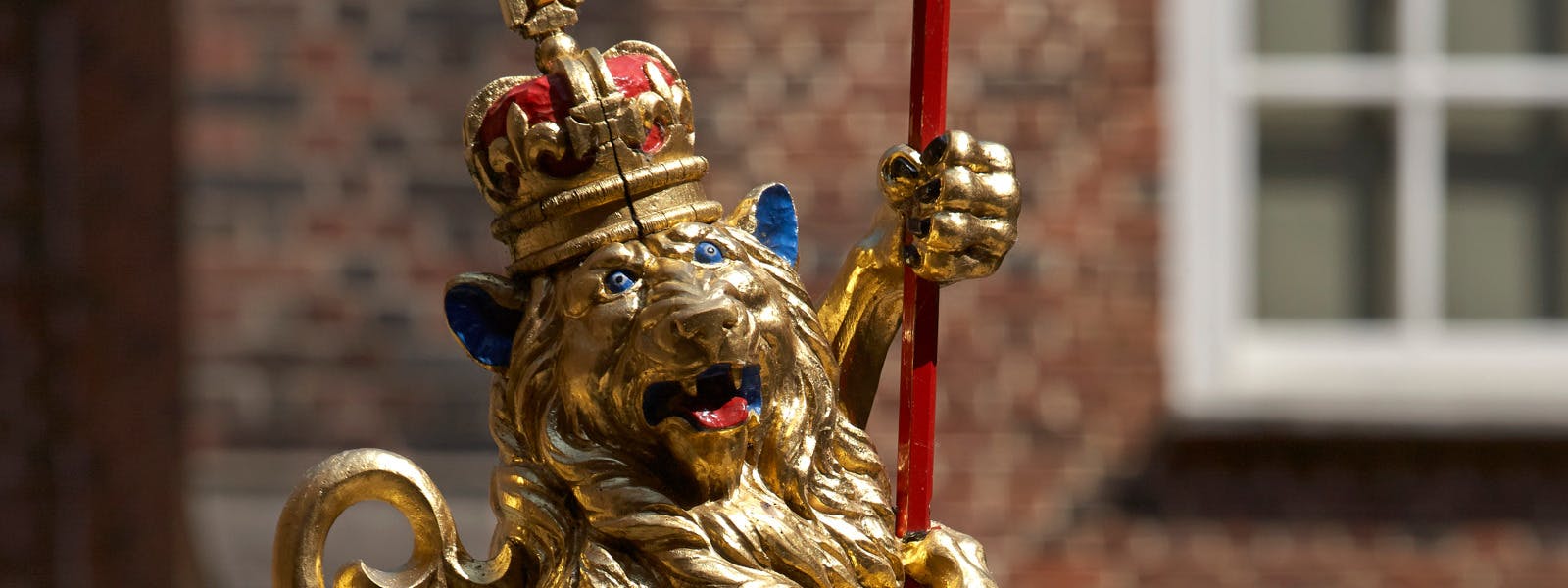
Images of real animals and mythical beasts have been adopted by the Royal Family and aristocracy as personal emblems throughout history and they can often be found in coats of arms, palaces and institutions across the country. Many of these symbols were used by Queen Elizabeth II.
The Tudors used beasts as a form of branding. The animals were meant to say something about the Tudors’ own qualities and strengths. As many of the animals had been used by earlier royal dynasties, they also helped legitimise the Tudors’ right to rule by emphasising their pedigree and allegiances against any would-be rivals to the throne.
Henry VIII’s original Privy Garden at Hampton Court Palace featured ninety royal beasts above green and white stripped poles that emphasised his ancestry.
Today, Tudor beasts can be found at the palace's entrance on the Moat Bridge, on the Great Hall buttresses and in Chapel Court.
Recreated in 2009 to celebrate the 500th anniversary of Henry VIII’s accession to the throne, Chapel Court is home to eight beasts carved in English oak, each holding special significance to Henry VIII and his lineage.
1. Golden Lion of England
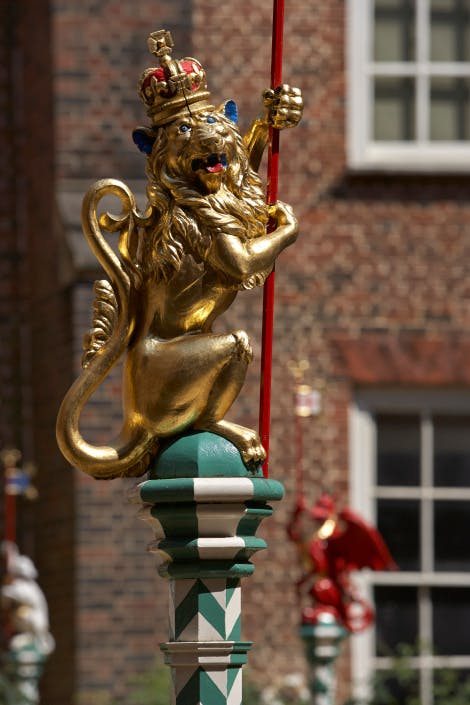
Used by
William I and monarchs since Richard I.
Appearance
A gold lion holding a vane with a reversed Tudor rose with white outer petals and a red inner rose.
History
The Lion of England has been used by monarchs since the early 12th century. The arms of three lions likely date to Richard I's reign when heraldry was officially recognised. The current coat of arms for England depicts the three lions walking.
Symbolism
Represents ‘Englishness’ and, later, ‘Britishness’ with qualities such as strength, courage, dignity and pride.
2. Falcon of the Plantagenets
Used by
Edward II and monarchs of the House of York and the Tudor dynasty.
Appearance
A falcon perched on a pillar, with one foot raised.
History
A falcon is a bird of prey domesticated for hunters to use. Edward III was the first to use the silver falcon in his royal arms, and his son Edmund of Langley, founder of the House of York, also used this symbol. Henry VII adopted the falcon as a King's beast when he married Elizabeth of York.
Symbolism
Represents resolve, determination and the high status of a monarch.

3. Silver Yale of Beaufort

Used by
The Beaufort family, Henry VII and Henry VIII.
Appearance
A mythical beast with the body of an antelope, the tusks of a boar, a lion’s tail and swivelling horns.
History
In 1443 Sir John Beaufort (Henry VIII’s great-grandfather) took the Bedford Yale as symbol for his coat of arms after being granted land. Since then, the yale has been regarded as a Beaufort beast. Margaret Beaufort, her son and grandson (Henry VII and Henry VIII) also came to use the yale.
Symbolism
Represents prowess and defence in battle.
4. Seymour Panther
Used by
Jane Seymour, the Beaufort family, Henry VII and Henry VIII.
Appearance
A panther with the tail of a lion and the claws of an eagle. It is commonly shown as ‘incensed’, angry or infuriated, with flames coming from its mouth and ears.
History
A heraldic symbol of Jane Seymour, the panther was added to Henry VIII’s Privy Garden in 1536, the same year Anne Boleyn was executed and Jane became Queen. Anne’s arms and badges were replaced by those of Queen Jane and the Seymour family.
Symbolism
Represented as a symbol of Christ.

Take a look around the Chapel Garden at Hampton Court Palace on our 360-degree image, created in partnership with Google Arts & Culture.
5. White Greyhound of Richmond

Used by
The House of Lancaster and Edmund Tudor.
Appearance
An upright greyhound wearing a chained collar and holding a vane bearing the fleur-de-lis, a French heraldic symbol.
History
Dogs have been favoured pets for the Royal Family for centuries. The House of Lancaster adopted the greyhound as one of their symbols and it became known as the Greyhound of Richmond when Henry VI granted a white greyhound to his half-brother Edmund Tudor (Henry VII’s father).
Symbolism
Represents loyalty and honour.
6. Red Dragon of Wales

Used by
The Tudor dynasty: Henry VII, Henry VIII, Edward VI, Mary I and Elizabeth I.
Appearance
A red dragon holding a vane bearing the flag of St George.
History
The red dragon of Wales has been used as an heraldic beast since medieval times, and it was adopted by Owen Tudor (Henry VIII’s great-grandfather) to emphasise his royal Welsh ancestry all the way back to Cadwalader, king of Gwynedd in the 7th century. Henry Tudor (later Henry VII) flew the red dragon on a flag of white and green Tudor colours – the first design of the Welsh national flag today.
Symbolism
Represents valour and bravery.
7. Black Bull of Clarence
Used by
The House of York and Henry VIII.
Appearance
A black bull with a vane bearing the flag of St George, featuring gold horns and hooves.
History
The black bull was used as a badge by Lionel of Antwerp, 1st Duke of Clarence, the second son of Edward III who was the ancestor of the Yorkist kings. It became a royal badge used by his descendant Edward IV and later by Henry VIII.
Symbolism
Represents bravery and transformation.

8. White Hart of York

Used by
Richard II, the House of York and the Tudor dynasty.
Appearance
The hart (or stag) stands upright, wearing a golden collar and chain and holding a vane with a Tudor rose.
History
The White Hart of York was adopted as a Yorkist badge and was also used in Edward V's coat of arms. The White Hart of Richard II is believed to have derived from his mother's coat of arms, Joan of Kent. It is said that it was also chosen as Richard II’s badge as a pun on his name Rich-hart.
Symbolism
Represents purity, piety and spirituality.
Explore what's on

- Things to see
Chapel Court
Explore an opulent Tudor pleasure ground in the inner precincts of Hampton Court Palace.
-
In line with palace opening hours
- Hampton Court Palace
- Included in palace admission (Members go free)

- Things to see
The Chapel Royal
Walk in the footsteps of kings and queens in the Chapel Royal.
-
Open Wednesday - Saturday
- 10:00 - 16:00
- Hampton Court Palace
- Included in palace admission (Members go free)

- Things to see
Hampton Court Gardens
Take time to explore and relax in these world-renowned gardens and find our free entry Garden Open Days dates.
- Open
- In line with palace opening hours
- Hampton Court Palace
- Included in palace admission (Members go free)
Browse more history and stories
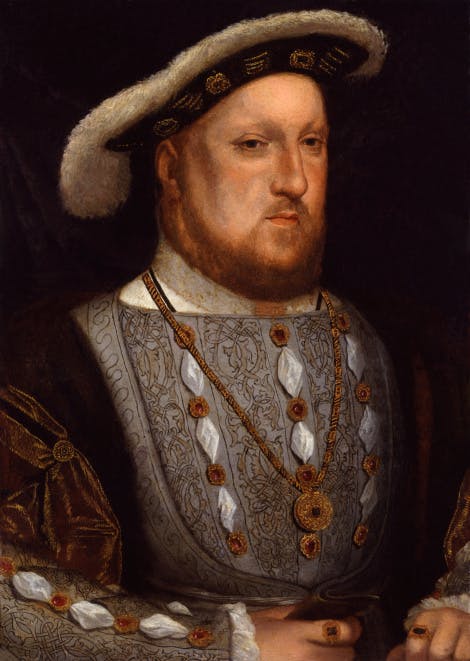
Henry VIII, Terrible Tudor?
Who was the real Henry VIII?

The royal court in the Tudor period
The Tudor royal court was the place to see, and be seen
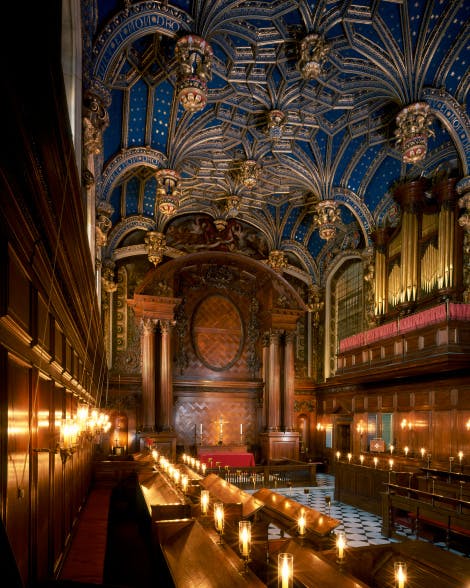
The story of Hampton Court Palace
Home of Henry VIII and the Tudor dynasty
Shop online
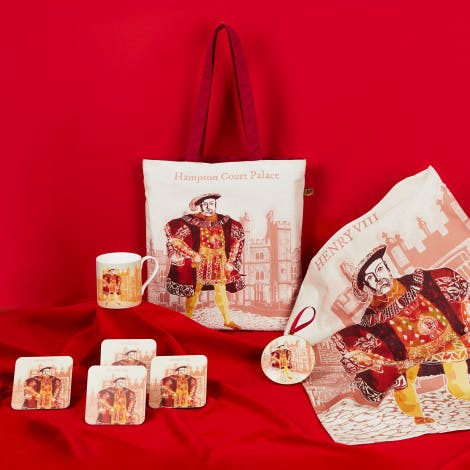
Shop Tudors
Find the perfect gift for collectors and history enthusiasts in our treasure trove of souvenirs inspired by this ever-fascinating dynasty.
From £3.00

Shop Hampton Court Palace
Explore our gifts and souvenirs, inspired by over 500 years of history from Hampton Court Palace.
From £2.50

Christmas homepage banner - Henry VIII and Six Queens Decoration Set
Christmas Homepage Banner - Henry VIII and Six Queens hanging decoration set on a Christmas tree at Hampton Court Palace.
£70.00
